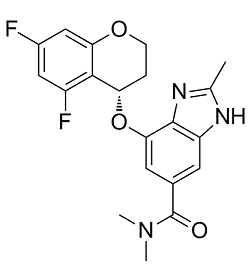This product is for research use only, not for human use. We do not sell to patients.

| Size | Price | Stock |
|---|---|---|
| 50mg | $880 | In Stock |
| 100mg | $1450 | In Stock |
| 200mg | $2175 | In Stock |
Cat #: V16014 CAS #: 942195-55-3 Purity ≥ 98%
Description: Tegoprazan, a novel and potent P-CAB (potassium-competitive acid blocker), is a next-generation therapeutics developed for the treatment of acid-related gastrointestinal diseases such as gastroesophageal reflux disease (GERD) and peptic ulcers, acting by controling gastric acid secretion and motility.
Publications Citing InvivoChem Products
Product Promise

- Physicochemical and Storage Information
- Protocol
- Related Biological Data
- Stock Solution Preparation
- Quality Control Documentation
| Molecular Weight (MW) | 387.38 |
|---|---|
| Molecular Formula | C20H19F2N3O3 |
| CAS No. | 942195-55-3 |
| Synonyms | Tegoprazan |
| Protocol | In Vitro | Tegoprazan inhibits porcine, canine, and human H+/K+-ATPase activity. Tegoprazan inhibits gastric H+/K+-ATPase in a potassium-competitive and reversible manner. Tegoprazan (3 μM) inhibits 86% of H+/K+-ATPase activity, whereas the inhibition is decreased to 34% after the dilution of Tegoprazan concentration to 0.15 μM |
|---|---|---|
| In Vivo | Tegoprazan (1.0 mg/kg, p.o.) potently and completely inhibits histamine-induced gastric acid secretion in dogs. Tegoprazan (1.0-3.0 mg/kg, p.o.) reverses the pentagastrin-induced acidified gastric pH to the neutral range. Tegoprazan (3 mg/kg, p.o.) immediately evokes a gastric phase III contraction of the migrating motor complex in pentagastrin-treated dogs |
| Solvent volume to be added | Mass (the weight of a compound) | |||
|---|---|---|---|---|
| Mother liquor concentration | 1mg | 5mg | 10mg | 20mg |
| 1mM | 2.5814 mL | 12.9072 mL | 25.8144 mL | 51.6289 mL |
| 5mM | 0.5163 mL | 2.5814 mL | 5.1629 mL | 10.3258 mL |
| 10mM | 0.2581 mL | 1.2907 mL | 2.5814 mL | 5.1629 mL |
| 20mM | 0.1291 mL | 0.6454 mL | 1.2907 mL | 2.5814 mL |
This equation is commonly abbreviated as: C1 V1 = C2 V2
- (1) Please be sure that the solution is clear before the addition of next solvent. Dissolution methods like vortex, ultrasound or warming and heat may be used to aid dissolving.
- (2) Be sure to add the solvent(s) in order.




































